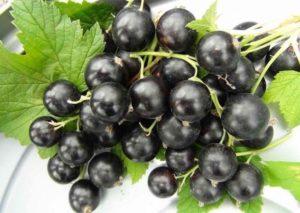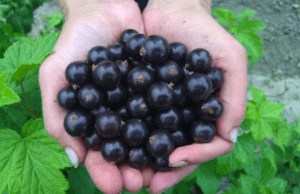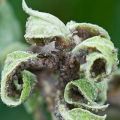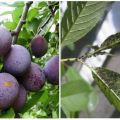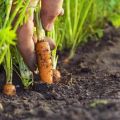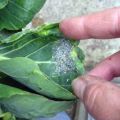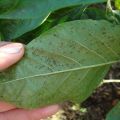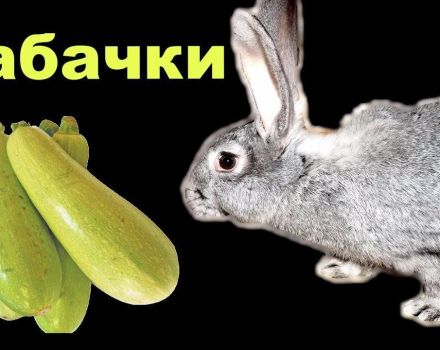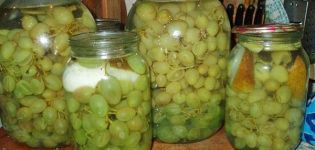How to deal with aphids on currants with chemical and folk remedies, processing rules
Currant is a berry that grows in many countries. Healthy fruits are tasty and suitable for canning. In the process of growing shrubs, gardeners are faced with insect pests. The size of insects is small, which does not prevent them from forming entire colonies, damaging the bush. Therefore, for summer residents, the question of how to deal with aphids on currants plays a special role.
Varieties of pests
Aphids are a small insect that feeds on the sap of plants growing in the garden. Summer residents grow a lot of vegetables and fruits, so there are many types of aphids. Some bugs feed exclusively on a specific plant, while others have adapted to attack several types of crops. The appearance of aphids is observed in early spring with the blooming of young leaves.
Gall aphid
The body length of the parasite does not exceed 2.5 mm. It is found on white, red and black currants. It is the causative agent of viral infections that enter the plant through insect bites. As a result, abnormal neoplasms are formed on the leaves, which are called galls.
Gooseberry
It lays eggs that calmly endure the winter at the base of the buds. The larvae appear in April. Sucking the juice from the buds, they gradually move to green shoots and petioles of newly opened leaves.

Winged individuals are found in spring and autumn. Summer is a favorable period for distribution. They look for plants with young shoots, settling on their tops. The gooseberry aphid parasitizes all types of currants.
Escape
You can calculate the insect by the shape of the leaves of the plant. They curl up like a cocoon. Aphids use them as protection against bugs that catch bugs. Unfolding the leaf, you can see a large number of aphids along with ants.
Redgall
After the larvae emerge from the eggs, they populate the lower part of the leaves. In the place of accumulation of insects, the leaves grow and become covered with swellings. Later, they acquire a reddish tint.

The main signs of damage to the bush
It is very easy to recognize that aphids are eating currants. There are small bugs on the branches, roots of leaves and their lower part. The bushes often have twisted leaves filled with insects inside.
Examining the currants every day, you can notice the appearance of ants climbing the branches.
If there are more affected areas of aphids, the fruits become smaller and fall off, never having time to reach maturity.
Why insects are dangerous for currants
With the first signs of damage to aphid bushes, it is necessary to start fighting. The insect feeds on plant sap, helping to stop the growth of new shoots. Gradually, the infected culture weakens and dies.
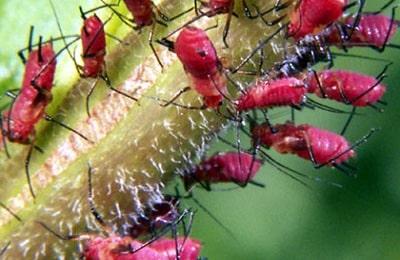
In the risk zone, not only red currants, but also other species. Colonies working with black ants are the most dangerous. They accelerate plant death by transferring aphids to other parts of the greenery.
What is the connection between ants and aphids?
Ants protect aphids from insect enemies that destroy them. They also transfer aphids to other plants, providing them with food. In turn, the aphids secrete a sticky sweet liquid and leave on the leaves, which the ants feed on. This feature is typical for white, red, green, black and other types of aphids.
Ways to deal with the invasion of aphids and ants
To save the currant bushes from the invasion of aphids, they begin to fight in the spring. Insect control measures are developed depending on the degree of damage to the culture. If aphids are few, traditional medicine will help.
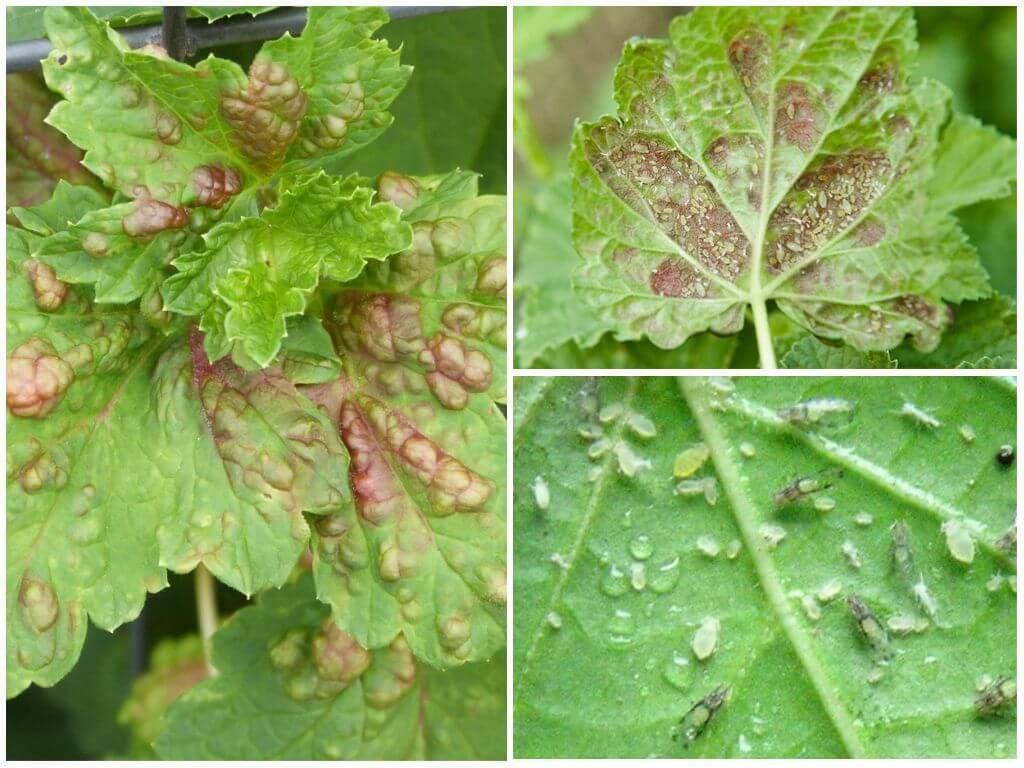
More aggressive methods are used against large infestations of parasites. If an aphid attack has led to the emergence of new colonies, drugs of chemical origin are used. These are fungicides and insecticides.
Folk remedies
For the preparation of solutions that are sprayed on the culture, different products are used. Most are always at hand. Some can be purchased at the pharmacy, as they are freely available. These are drugs familiar to every person from early childhood.
Ammonia
The tool not only helps to defeat aphids on currants, but also saturates the bushes with nitrogen. There is an acceleration of their growth, the formation of berries and the healing of injuries that were obtained as a result of parasitizing aphids. The recipe for baiting is easy to make at home.
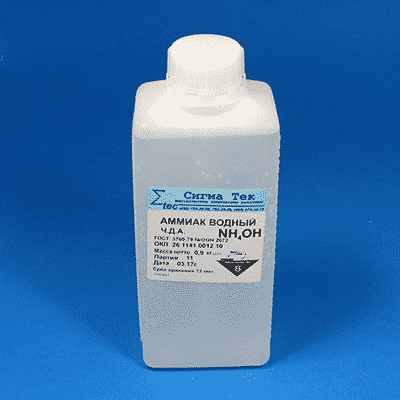
55 ml of ammonia is dissolved in 12 liters of water. A pinch of washing powder is added before spraying. A wide-tipped watering can can be used instead of a treatment apparatus. Insect baiting occurs only once on one bush. The second treatment procedure is carried out after 2 weeks. Frequent spraying is prohibited, as it leads to an excess of nitrogen. The destruction of aphids by ammonia occurs in the first 3 days after spraying.
Vinegar
You can get rid of bushes of small bugs with another tool that is always present in the kitchen of any housewife. Vinegar is a liquid that helps fight aphids regardless of the growing season of the currant. Suitable for spraying bushes on which berries ripen. You will need 25 ml of vinegar for a bucket of water. The liquid works for 1.5 weeks depending on the weather. The sour smell and aroma of vinegar keeps insects away.
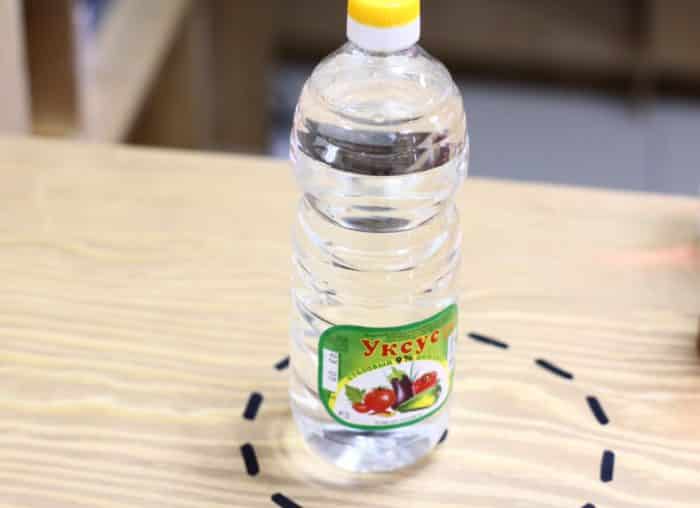
Soda
As a result of mixing powder and water, a solution is obtained that is used for spraying. Experienced gardeners are advised to replace regular soda with soda ash. Iodine is added as an additional agent.
Ash
In the old days, there were no drugs on the market to combat plant diseases. For this purpose, the means at hand were used. Ash was considered one of the most effective. It is still used in agriculture. Ash scatters over currant bushes, as well as soil. A solution is prepared on its basis. Ash allows you to completely get rid of aphids in 4-5 treatments.

Tobacco
Spraying with tobacco-based liquid is carried out three times per season:
- before the buds appear;
- after flowering;
- at the time of ripening of berries.
Tobacco, like ash, can be used undiluted.In order not to prepare solutions, the plant is planted near shrubs. The culture requires constant care, but thanks a person by scaring away aphids and other pests.
Soap
Making recipes using simple products involves adding soap. Thanks to him, parts of the plant are covered with a protective film, making it difficult for aphids to feed and hindering movement. For spraying, a soapy solution prepared in water is useful. It can be grated laundry soap or liquid soap.
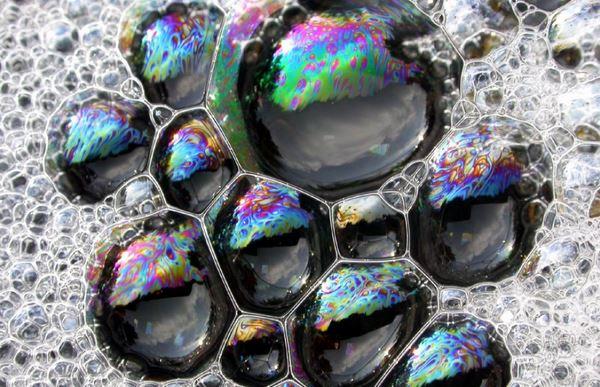
The usual is replaced with tar. Eliminates aphids on currant branches, and also helps the plant recover faster. It is known that birch tar is a substance with medicinal properties.
Mustard
The spice is valuable in the fight against aphids because of its pungent odor and bitter taste. Mustard powder is useful for preparing the solution. A bucket of water will need 10 tbsp. l. mustard.
Garlic
Garlic tincture works well. In order for the liquid to acquire a rich bitter taste, the raw materials are initially crushed. After infusion, it is filtered and used as a spraying agent. Garlic can increase the protective properties of the plant's immune system.
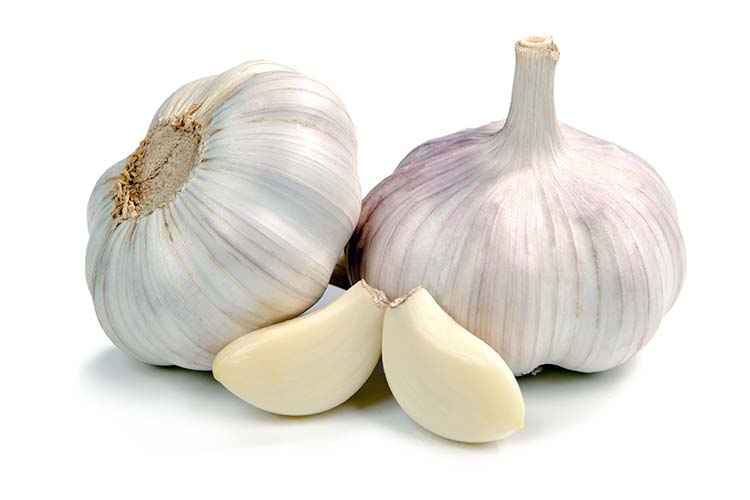
Serum
The dairy product is used in its pure form without preliminary preparation. It repels insects with a sour and pungent odor. For the rapid destruction of parasites, spraying is carried out every 3 days. For preventive purposes, 1 procedure per week is sufficient.
Vodka
Features of preparation and use are the same as whey. When spraying a plant with vodka, special attention is paid to the back of the leaves. You can get rid of the shoot aphid by dousing the branches.

Potassium permanganate
During the preparation of the solution, it is recommended to strictly adhere to the dosage. If you overdo it with potassium permanganate, you can destroy the plant. The drug is diluted in 1 liter of water so that the liquid has a rich color. Then the solution is poured into a bucket of water, after which it is ready for spraying.
Celandine
Fresh grass is crushed and filled with 12 liters of water. The mixture is left to infuse for at least a day. It is filtered before use.
Infusion of leaves and tops of potatoes
Fresh raw materials, pre-cut with a knife, will come in handy. This will speed up the release of the juice and mix it with water. The container with the mass is put on fire and brought to a boil. The liquid can be stored in a cool place and the required amount can be diluted with water before use.

Infusion of marigolds
Most effective against gall aphids. The collected marigolds are filled with water and infused for several days. The solution should be saturated with a pungent odor. For ease of use, it is filtered.
Pharmacy chamomile
It is prepared like any herbal remedy. Raw materials are poured with water and infused. The concentrated broth is diluted with water and used as a spray.
Ammonia
The purchased product in a pharmacy kiosk fights against the invasion of aphids on currant bushes. If there are few insects, open jars are placed throughout the garden. To remove entire colonies, a solution is prepared.
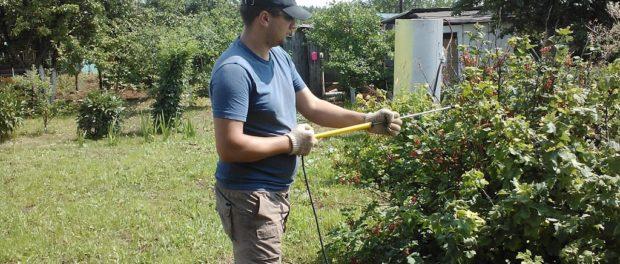
Fumigation
The procedure is performed during the period of kidney swelling. Aromatic herbs are used as raw materials for decay. It can also be clipped tree branches.
Orange peels
The peel that remained after the eaten oranges is not in a hurry to throw away. The more bitterness in the crusts, the better the result will be. The solution is prepared in a standard way - by infusing the raw material in water with filtering before use.

Manual removal
It is considered the easiest way to combat aphids. The bugs are washed off with water from a hose. Most of the insects die under running water during processing. The procedure is useful if there are few aphids on the bushes.
Individuals are destroyed by hand. The person is advised to wear medical gloves.
Pruning
Another event that does not imply the use of pre-prepared solutions. Affected branches are pruned with a pruner. Twisted leaves are also torn off. The cut off parts of the bushes are removed from the site and set on fire. \
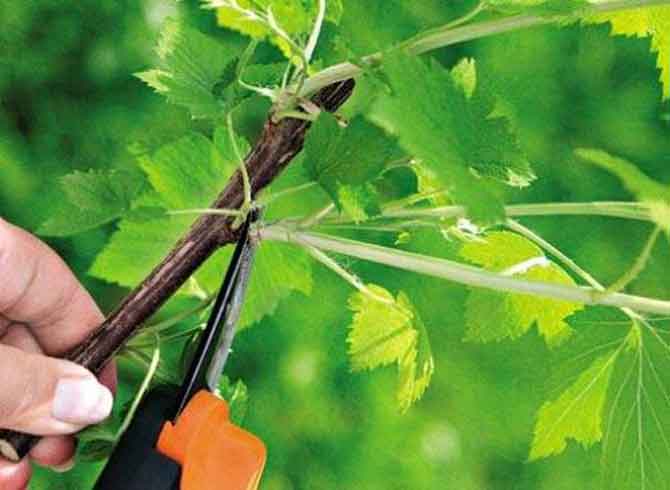
Biologicals and chemicals
It is possible to remove signs of plant damage by aphids using chemicals. But the use is limited to certain periods of the growing season. Insecticides are permitted for spraying in early spring before flowers appear. Poisonous substances that enter the tissue of currants during processing remain in it for up to a month.
Aphids are also removed with biological products. They act much more slowly, but not as harsh as chemicals. They are based on the waste products of microorganisms, which have the peculiarity of destroying aphids. They do not harm the human body, but are not recommended for use before harvest.
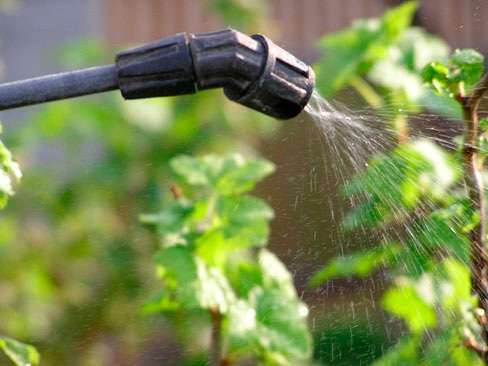
When and how to process
The choice of a spray agent is one of the important stages in the fight against bugs. To get rid of insects, you need to know the technology of processing plants, terms and rules. Failure to follow the recommendations can destroy not only the crop, but also the plant itself.
Technology and rules
The gardener should familiarize himself with the following nuances:
- Spraying is carried out on windless days.
- In the evening or morning.
- Young shoots are completely dipped in a container with a solution.
- Healthy branches on an infected bush are also subject to processing.
- The lower part of the leaves is washed by hand.
The currants are processed evenly. Particular attention is paid to the middle of the bush. There should be no untreated space on the plant.
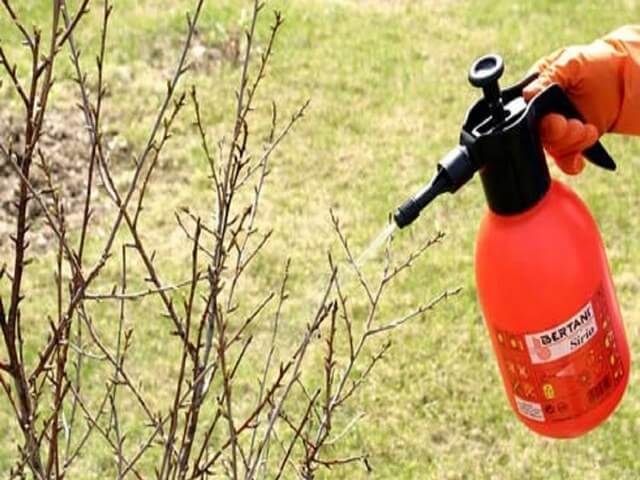
Timing
The minimum number of treatments is 4 times. In the summer, spraying is repeated after precipitation. This is usually June. Before the formation of green fruits, chemicals are used. Within a month, the poison will be gradually removed from the culture. Chemicals are allowed in the fall as well. Spraying after harvest helps to kill eggs laid by aphids to parasitize in the next season.
If there are already berries on the branches, traditional medicine is used. They will not harm the human body during the ripening period. Vinegar, whey, vodka, herbal infusions - what is allowed during the fruiting of currants.
Prevention Tips
Protecting currant bushes from aphids is easier than trying to get rid of insect infestations. To do this, gardeners use simple but effective methods. The person must take care of the protection of the crop throughout the growing season.
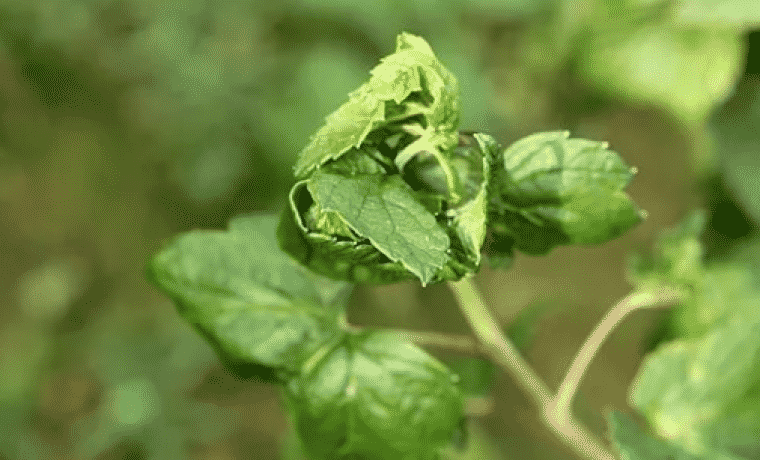
Plants that repel aphids
Plantings that emit a rich aroma repel aphids. Due to the smell, the insect cannot live and reproduce on the site, therefore it leaves it. Suitable plants are lavender, marigold, mint, coriander and garlic.
"Nitrafen"
The drug is a rich brown paste. It is characterized by complex action. It is used in early spring to kill aphid eggs, from which insects appear with the onset of summer.
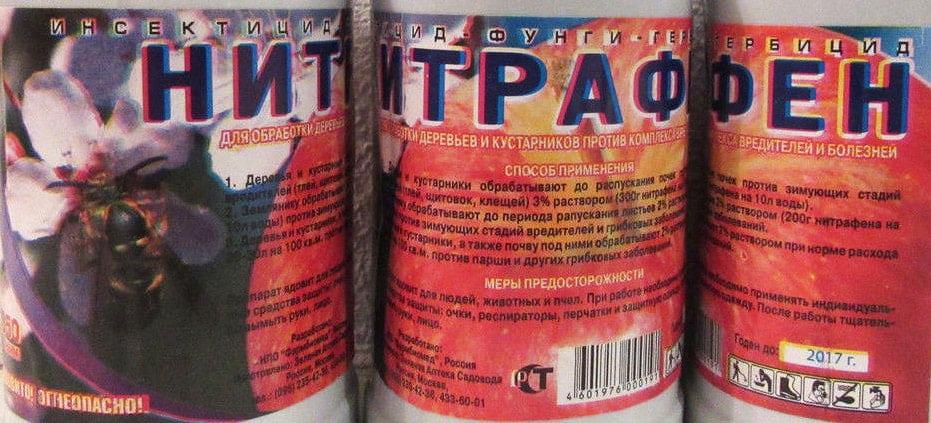
Weeding
The area where fruit shrubs and trees grow should be free of weeds. They become a good hiding place for insects. During the entire growing and fruiting season, currants are removed.
Timely and proper care
It consists in simple actions that people often underestimate. This includes watering, weeding, and inspecting the bushes. You should also take care of the neighborhood of currants.
Pouring boiling water
To avoid the appearance of aphids and their spread, it is recommended to first fight the ants. If there are anthills on the territory of the garden, urgent measures are taken to destroy them. To do this, it is enough to water the soil under the bushes with boiling water.
The gardener has every chance of avoiding aphid infestation of the currant.This is not as difficult as it seems at first glance. To do this, you need to devote time to basic care of the bushes. With the appearance of the first signs of insects, carry out the treatment.
